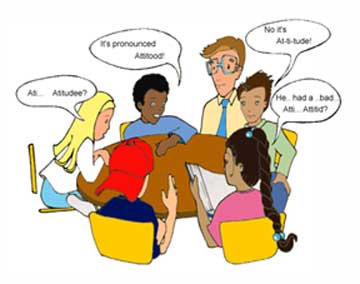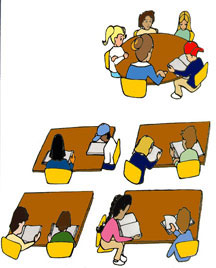 |
BME637
: The Class
: Communication
: Theory
: Online Lesson 1
Online Lesson 1:
Part III: An Illustration
Small Group Reading Lessons
Let's explore small group reading lessons. In a teacher-centered reading
lesson, students are sitting in a square or circle (depending on the table
shape). They are expected to display the expected postural configuration
for reading. That is, they have to sit straight, with both hands on the
tabletop. The teacher monitors the students in the group making sure that
everyone is sitting correctly and making sure that their books are opened
to the right page. The teacher makes explicit the task at hand. S/he tells
the students that each will read one paragraph taking turns starting from
the right side and moving through the circle in order. So Johnny, sitting
next to the teacher, reads first, followed by Maria who is next to him,
followed by Jack who is next to Maria. The turns at reading continue until
the last student reads his/her paragraph. This is a typical teacher-centered
reading lesson. It is teacher-centered because the teacher controls the
turns at reading and more importantly, the teacher is the only participant
allowed to interact or correct individual students as they read. The other
students must display the expected "engagement" etiquette as
each individual student reads. What are teacher assumptions in this lesson?
The teacher assumes that the students are engaged because they are displaying
the expected engagement etiquette that the teacher reinforces. They are
expected to read the same paragraph that the reader is reading, and they
display this by looking at the book, being on the right page, pointing
with their fingers the paragraph at hand, and sitting "quietly"
until it is their turn. In Illustration A below I provide a picture of
what students may be doing in this teacher-centered lesson.
 Illustration A Illustration A
When Johnny
began to read, what would a smart child like Maria really do when she
knows she has to read the next paragraph after Johnny finishes his? She
probably is practicing reading her own paragraph. What may the other students
be doing when it isn't their turn? They too could be practicing at their
own paragraph as Johnny reads. How does the teacher detect that all the
students are engaged in the lesson as individuals take a turn at reading?
It is now Maria's turn at reading and what might Johnny be doing? While
he's displaying the appropriate etiquette for group reading he also might
be disengaged because after all, he's already finished his assigned task.
How does the teacher know that he is still engaged? He could be faking
engagement, and all the teacher has as evidence of engagement is the proper
physical display of reading etiquette. Why should a student read along
silently with others when they are no longer readers? Why would they read
silently when they are no longer held accountable since the teacher switches
focus from one reader to the next? There is no guarantee that students
in these kinds of teacher-centered contexts are actually engaged! Students
and people like you and me are socially bright and know when to enter
and leave contexts, i.e., they know how to engage and disengage without
being detected.
Illustration B is an example of a student-centered small group reading
lesson. For my doctoral dissertation, "Collective Engagement in the
Segundo Hogar: A Microethnography of a bilingual classroom" (1986),
I described a student-centered small group reading lesson where the students
shared the responsibility of teaching. The teacher did not have a linear
approach to turn taking. She asked for volunteers. No one knew his/her
turn in advance. Moreover, she did not specify the limitation of one paragraph
per reader. Whenever Juanito read and had trouble in reading, each of
his peers would help, often helping simultaneously as in Illustration
B. 
Illustration B
The teacher would be the last person to help the reader and usually
the teacher would only intervene when the student peer teachers were not
providing the appropriate help. So when the teacher detected that all
the students were having problems with the same issue, then she provided
correction to not only the reader but to all the group who were on-task,
and truly engaged in the reading lesson as evidenced by their helping
interactions! How could they help their peers if they weren't paying attention
to the reading? My research showed that these children in a student-centered
reading lesson were actually engaged as evidenced by they contributions
to the activity. There were times in the reading lessons I studied that
the teacher disengaged herself from the lessons due to a monitor coming
in to deliver a message from the principal's office or misbehavior by
the other students not in the lesson. In teacher-centered lessons, students
also disengage themselves when the teacher disengages because the lesson
is dependent on the teacher. They normally stop everything and re-engage
only when the teacher returns to the lessons. In our example of the student-centered
lessons, when the teacher disengaged herself from the lesson, the lesson
did not stop; it continued without the teacher because teaching was a
shared responsibility ----the students remaining engaged in the lesson!
Let's move on to another example that Dr. Ray McDermott and his associates
discovered in their research. I also observed similar phenomena in my
own classroom research. This has to do with time on task and lesson engagement.
In the 80's there was lots of research that found that the more time you
spend on an academic task, the more you learn that academic content! This
seems very logical and I wonder why millions of dollars were spent to
come up with this finding. Related to this finding was that if time on
task is important, how does one know that they are actually on task, that
is, actually engaged in the academic activity? In this regard, McDermott
compared the reading activities of high and low reading groups in a classroom.
He focused on time on task and lesson engagement as he compared these
reading groups. Study Illustration C below.

Illustration C
This is a top view layout
of a classroom with the teacher teaching the "high" group (meaning
the best readers in the class). The teacher allocates 20 minutes of reading
time for each group. The approach for each reading group was teacher-centered
as the example above. The high reading group lesson went smoothly and
the teacher was totally engaged in the lesson for the 20 minutes allotted.
They read and discussed the passages and they seemed to be engaged in
the lesson. Let us assume that even in this teacher-centered lesson, everyone
was engaged in the reading activity. They had 20 minutes of quality reading
time. In the low reading group (the worst readers---and in McDermott's
research, the worst readers were minority children), it was a different
story altogether. See Illustration D.

Illustration D In this top view of the same classroom
we see differences in teacher position at the reading table as compared
to the high group. It was found that in the low reading group there were
many outside interruptions, and the teacher and students were consistently
disengaged. In the high group there were no interruptions. Can you see
why? It was discovered that the low group did not spend the full 20 minutes
engaged in the lesson due to the many outside interruptions that the teacher
allowed and acknowledged. Comparing the time spent engaged in the high
and low groups, the high spent more time on task while the low group spent
less time on task, and this contributed to the widening gap between the
two groups. The good readers became better readers while the slow readers
fell farther behind. What happened in this low group scenario? The teacher
working with the high group (Illustration C) had her back to the rest
of the class concentrating only on her fast readers! The rest of the class
did not have eye contact with the teacher so they couldn't get her attention.
When the teacher worked with the low group, she placed herself facing
not only her reading group but also all the class! Students, like all
of us, know how to get people's attention. It is easier to get the teacher's
attention when one is in line with the teachers view or periphery! One
can make large arms movements to get the teacher's attention and if one
can connect with the teacher's eye gaze, then one can initiate an interaction
forcing the teacher (and the reading students) to disengage from the lesson.
This is what happened, and this low group of readers spent much of their
allotted 20 minutes disengaging and re-engaging taking precious time from
quality reading lessons…and this was simply due to the position at the
reading table. The reasons for these two different teacher positions may
very well be that the teacher enjoyed teaching reading with "good"
readers. Don't we all? It is a harder task to teach slow readers and many
teachers do not enjoy teaching children pronunciation and others problematic
issues. It is also hard to have cognitively demanding higher-order discussions
on reading comprehension due to poor reading skills. I can see why some
teachers may want to minimize this "pain." But this is not what
I call good teaching practices. Nevertheless, the point of this example
is that a simple change in teacher position can have major educational
implications!
We can expand the "time on task" theory as we observe other
areas in classroom culture. For example, "getting ready" to
end a lesson and "getting ready" to begin a lesson takes time---that
is takes valuable time away from academic activities. How long does it
take to begin a lesson? I have observed many teachers spending more than
five minutes just to get students engaged in the lessons, and when the
lesson is over, another five minutes are spent in disengaging from that
lesson (putting your seat back, putting your books and materials away,
etc.). Then another five minutes are spend to start a new academic activity!
If one were to sum the number of minutes spent in a normal classroom day
for "getting ready and getting done," one would be astounded.
Once you have finished you should:
Go on to Online Lesson - Part IV
or
Go back to Topic 1: General Communication Theory
|


